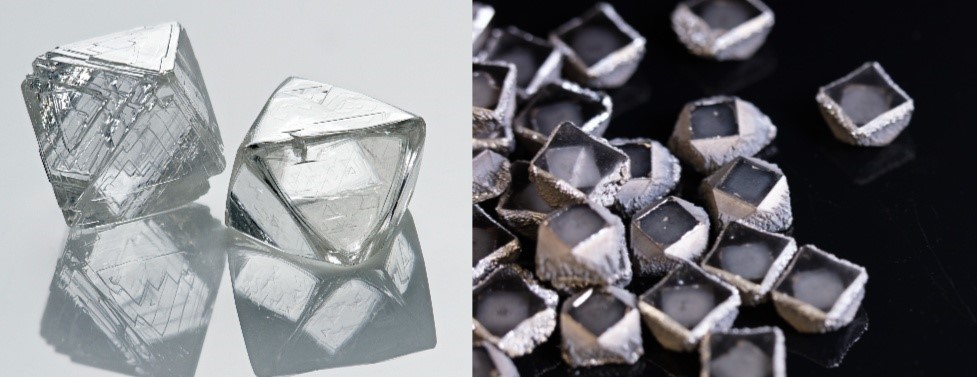
From left to right: Natural rough diamonds (photo by Leo Bieber), CVD (Carbon Vapor Deposition) seed crystal laboratory-grown diamonds
Natural Diamond Council, the authoritative resource on natural diamonds, has released its 2023 analytical report entitled, Diamond Facts: Addressing myths and misconceptions about the diamond industry. Through this report, the Natural Diamond Council (NDC) has set out to address misinformation about both natural diamonds and their synthetic counterparts.
“In an age where consumers are more inquisitive and enlightened than ever, they wish to know about the values and responsible business practices from the companies and indeed the wider industry from which they are purchasing,” says David Kellie, CEO of the NDC. “At the Natural Diamond Council, we want to support consumers in taking informed decisions by providing information transparently.”
The report tackles common misconceptions about the diamond industry. Examples of facts from the report include:
Highlight: Laboratory-grown diamonds can be detected from natural diamonds.
Supporting Facts:
* All laboratory-grown diamonds can be detected using professional verification instruments.
* Mass-produced in just a few weeks, unlike the billions of years it takes for a natural diamond to form under the earth’s surface, laboratory-grown diamonds exhibit specific growth-related features and patterns.
Highlight: Not all laboratory-grown diamonds are sustainable.
Supporting Facts:
* Laboratory-grown diamonds replicate the natural diamond creation process which requires a mass amount of electricity, mostly from the national grid.
* Over 60% of laboratory-grown diamonds are mass-produced in China and India where 63% and respectively 74% of grid electricity results from coal.
* The manufacturing of laboratory-grown diamonds can require temperatures similar to 20% of the temperature of the Sun’s surface.
Highlight: The process of natural diamond formation means that they are inherently rare. They are a finite natural resource.
Supporting Facts:
* Formation takes place across the span of millions, sometimes billions, of years and occurs in limited zones of the earth’s mantle at extreme temperatures and pressures.
* Global natural diamond recovery peaked in 2005 and has decreased by over 30% in the last 16 years.
* The annual recovery of 1 carat diamonds is equivalent in volume to an exercise ball.
Highlight: Laboratory-grown diamonds have experienced significant price depreciation in recent years.
Supporting Facts:
* From 2016 to 2023, the average price of a 1.5 carat laboratory-grown diamond has decreased by over 74%.
* Whilst the natural diamond prices have also fluctuated, over the last 35 years, on average, they have risen by 3% per annum.
Highlight: Ethical sourcing is a priority for the natural diamond industry.
Supporting Facts:
* Under the Kimberley Process, mandated by the United Nations and the World Trade Organization, the trading of rough diamonds is strictly regulated to ensure it is conflict-free.
* Responsible Jewellery Council (RJC) warrants responsible sourcing through third party audited certifications.
* Brands, retailers, and jewelers are increasingly implementing ethical sourcing protocols and policies bringing transparency to their supply chains.
Highlight: Natural diamonds help protect the biodiversity over an area equivalent to New York City, Chicago, Washington D.C., and Las Vegas combined. This is close to four times the land used by NDC member companies for natural diamond recovery, globally.
Supporting Facts:
* De Beers Group, a leading diamond company, is partnering with Kelp Blue, exploring kelp’s potential to store carbon, whilst improving marine health.
* The Diamond Route is a network established by De Beers Group to protect critical wildlife habitats in South Africa and Botswana.
Highlight: Natural Diamonds benefit the countries from which they originate. The natural diamond industry supports the livelihood of 10 million people worldwide.
Supporting Facts:
* Up to 80% of rough diamond value remains with local communities in the form of local purchasing, employment benefits, social programs, investment in infrastructure as well as the taxes, royalties and dividends paid from the industry to respective governments.
* For NDC members, 85% of all procurement is local.
* In Canada, the natural diamond industry contributes to 24% of total GDP in the Northwest Territories, $17 billion went toward (NWT) businesses and $7.5 billion to Indigenous owned (NWT) businesses.
For additional facts about the diamond industry where topics including traceability, stockpiling and other misconceptions are addressed visit:
https://www.naturaldiamonds.com/in/diamond-facts-info/diamond-facts/
The findings of this analysis have been derived from a thorough review of a wide range of secondary research conducted by globally respected third-party organizations. Industry experts and independent sustainability advisors were also consulted on the topics covered.

